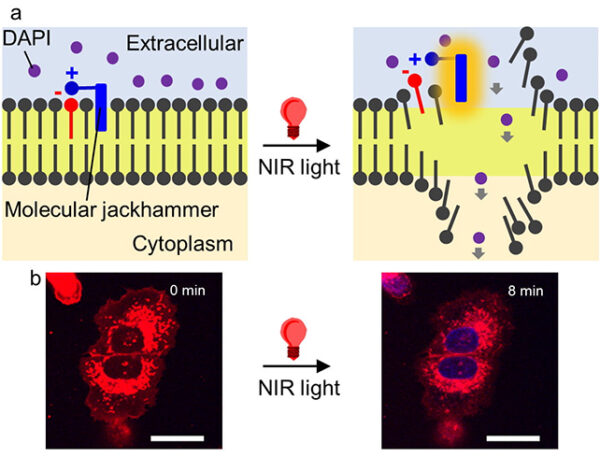
Posted on 12/28/2023 9:38:23 AM PST by Red Badger
Scientists have discovered a new way to destroy cancer cells. Stimulating aminocyanine molecules with near-infrared light caused them to vibrate in sync, enough to break apart the membranes of cancer cells.
Aminocyanine molecules are already used in bioimaging as synthetic dyes. Commonly used in low doses to detect cancer, they stay stable in water and are very good at attaching themselves to the outside of cells.

How the vibration mechanism works. (Ciceron Ayala-Orozco et al., Nature Chemistry, 2023)
The research team from Rice University, Texas A&M University, and the University of Texas, says the new approach is a marked improvement over another kind of cancer-killing molecular machine previously developed, called Feringa-type motors, which could also break the structures of problematic cells.
"It is a whole new generation of molecular machines that we call molecular jackhammers," says chemist James Tour from Rice University.
"They are more than one million times faster in their mechanical motion than the former Feringa-type motors, and they can be activated with near-infrared light rather than visible light."
The use of near-infrared light is important because it enables scientists to get deeper into the body. Cancer in bones and organs could potentially be treated without needing surgery to get to the cancer growth.
In tests on cultured, lab-grown cancer cells, the molecular jackhammer method scored a 99 percent hit rate at destroying the cells. The approach was also tested on mice with melanoma tumors, and half the animals became cancer-free.
The structure and chemical properties of aminocyanine molecules mean they stay in sync with the right stimulus – such as near-infrared light. When in motion, the electrons inside the molecules form what's known as plasmons, collectively vibrating entities that drive movement across the whole of the molecule.
"What needs to be highlighted is that we've discovered another explanation for how these molecules can work," says chemist Ciceron Ayala-Orozco from Rice University.
"This is the first time a molecular plasmon is utilized in this way to excite the whole molecule and to actually produce mechanical action used to achieve a particular goal – in this case, tearing apart cancer cells' membrane."
The plasmons have an arm on one side, helping to connect the molecules to the cancer cell membranes while the movements of the vibrations bash them apart. It's still early days for the research, but these initial findings are very promising.
This is also the kind of straightforward, biomechanical technique that cancer cells would find it hard to evolve some sort of blockade against. Next, the researchers are looking at other types of molecules that can be used similarly
"This study is about a different way to treat cancer using mechanical forces at the molecular scale," says Ayala-Orozco.
The research has been published in Nature Chemistry.
Commentor: “The experiments described all took place in vitro”
Article: “The approach was also tested on mice with melanoma tumors, and half the animals became cancer-free.”
That is correct.
But a cancer cell and a normal cell would have a different ‘resonant frequency’, and you would have to find that frequency by trial and error. Even different parts, cell types, of the body would have a different frequency for the same cancer...........
Note from Texas -— Y’all are welcome!!!
Signed:
Rice University, TEXAS A&M UNIVERSITY, and the University of Texas
What?
No TCU or SMU?.................
You are correct.
TCU or SMU?
I believe I recall them from football many, many years ago -— are they still around (wink, wink, grin) . . .
I’m wondering what would keep it from doing havoc to other good cells. I Have 2 ideas:
1. Do cancer cells have a unique molecule they can target at a certain frequency?
2. I know Cancer cells take up sugar faster than normals cells. Is there some special molecule that can be excited that cancer cells would take up (or at higher concentrations) and normal cells would not? Then they can target those cancer cells having that molecule.
I like Heinlein; but I’ve never read that work of his.
It portrays the aftermath of conquest of the USA by the ‘Pan-Asian’ Empire, i.e. China.........................
This is very interesting to me. We use more laser and light therapy quite successfully in VetMed than I think they do in MdMed -— probably because the drug dollars and insurance money isn’t there yet in VetMed.
Current cancer therapy doesn’t spare the non-cancer cells either -— at least not nearly as much as we would like them to. I am interested in any protocol that can kill cancer better than what we have now.
Boogie your way to a cancer-free life. Shake that thing!
I envision a machine like a MRI or CAT that the patient is put on a sliding platform and slowly processed through the machine while being subjected to various frequencies for different cancers to be found in the body, aided by the MRI computer for precise locations of targets.
It would probably take several treatments to eventually emerge cancer free..................
I wonder how that Slim Whitman song from “Mars Attacks” would fare against these cells?
I’ll check my local library for it. Thanks for the recommendation.
The article describes using the same dyes used to identify cancer cells to begin with can also be used with the IR source to create the effect.
IR lasers are a well developed technology as are cell marker dyes.
That would kill the patient...............
Lol
You might have a point there 😉
I read that book in grade school. Turned me into a huge Heinlein fan.
L
Disclaimer: Opinions posted on Free Republic are those of the individual posters and do not necessarily represent the opinion of Free Republic or its management. All materials posted herein are protected by copyright law and the exemption for fair use of copyrighted works.